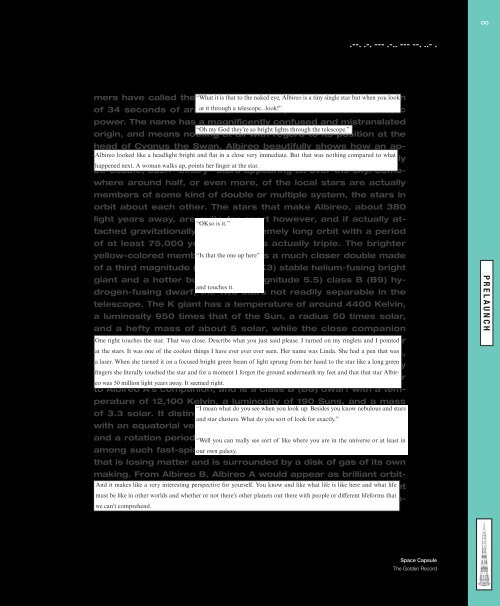You also want an ePaper? Increase the reach of your titles
YUMPU automatically turns print PDFs into web optimized ePapers that Google loves.
∞<br />
.--. .-. --- .-.. --- --. ..- .<br />
mers have called the “What pair it is topaz that the and naked eye, sapphire. Albireo is a tiny With single star a but separation<br />
when you look<br />
of 34 seconds of arc, at it the through pair a telescope...look!” is easily seen at low telescopic<br />
power. The name has a magnificently confused and mistranslated<br />
“Oh my God they’re so bright lights through the telescope.”<br />
origin, and means nothing at all with regard to its position at the<br />
head of Cygnus the Swan. Albireo beautifully shows how an apparently<br />
single star as viewed through the telescope can actually<br />
Albireo looked like a headlight bright and flat in a close very immediate. But that was nothing compared to what<br />
happened next. A woman walks up, points her finger at the star.<br />
be double, such “binary” stars appearing all over the sky. Somewhere<br />
around half, or even more, of the local stars are actually<br />
members of some kind of double or multiple system, the stars in<br />
orbit about each other. The stars that make Albireo, about 380<br />
light years away, are quite far apart however, and if actually attached<br />
gravitationally have an extremely long orbit with a period<br />
“OKso is it.”<br />
of at least 75,000 years. Albireo is actually triple. The brighter<br />
yellow-colored member, “Is that Albireo the one up here” A, is a much closer double made<br />
of a third magnitude (3.3) class K (K3) stable helium-fusing bright<br />
giant and a hotter but dimmer (magnitude 5.5) class B (B9) hydrogen-fusing<br />
dwarf, the two stars not readily separable in the<br />
and touches it.<br />
telescope. The K giant has a temperature of around 4400 Kelvin,<br />
a luminosity 950 times that of the Sun, a radius 50 times solar,<br />
and a hefty mass of about 5 solar, while the close companion<br />
comes One right touches in at the star. 11,000 That was Kelvin, close. Describe 100 what you solar just said luminosities, please. I turned on my and ringlets 3.2 and I pointed solar<br />
masses. at the stars. It was On one average of the coolest things separated I have ever ever by ever about seen. Her name 40 was Astronomical Linda. She had a pen that Units, was<br />
a laser. When she turned it on a focused bright green beam of light sprung from her hand to star like a long green<br />
they take almost 100 years to go about each other on highly<br />
fingers she literally touched the star and for a moment I forgot the ground underneath my feet and that that star Albireo<br />
was 50 million light years away. It seemed right.<br />
eccentric orbit. The visually-seen blue star, Albireo B, is similar<br />
to Albireo A’s companion, and is a class B (B8) dwarf with a temperature<br />
of 12,100 Kelvin, a luminosity of 190 Suns, and a mass<br />
“I mean what do you see when you look up. Besides you know nebulous and stars<br />
of 3.3 solar. It distinguishes itself by being a very rapid rotator<br />
and star clusters. What do you sort of look for exactly.”<br />
with an equatorial velocity of at least 250 kilometers per second<br />
and a rotation period “Well less you than can really 0.6 see sort days. of like where As is you so are in often the universe the or at case least in<br />
among such fast-spinning our own galaxy. stars, Albireo B is a “B-emission star”<br />
that is losing matter and is surrounded by a disk of gas of its own<br />
making. From Albireo B, Albireo A would appear as brilliant orbiting<br />
And it orange makes like a and very interesting blue perspective points for about yourself. You half know a and degree like what life apart, is like here the and K what giant life<br />
must be like in other worlds and whether or not there’s other planets out there with people or different lifeforms that<br />
shining with the light of 35 full Moons, the close class B companwe<br />
can’t comprehend.<br />
PRELAUNCH<br />
<strong>Space</strong> <strong>Capsule</strong><br />
The Golden Record



![Interdesign : Detroit [brand guideline]](https://img.yumpu.com/58113027/1/190x148/interdesign-detroit-brand-guideline.jpg?quality=85)
